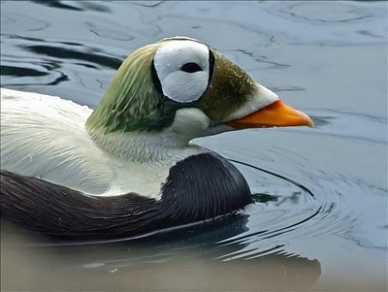Alaska Species Explorer
All
x
- – No known individuals remaining.
- – Known only to survive in captivity, or as a naturalized population outside its historic range.
- – Extremely high risk of extinction in the wild.
- – High risk of extinction in the wild.
- – High risk of endangerment in the wild.
- – Likely to become endangered in the near future.
- – Lowest risk. Does not qualify for a higher risk category. Widespread and abundant taxa are included in this category.
- – Not enough data to make an assessment of its risk of extinction.
- – Has not yet been evaluated against the criteria.
Spectacled Eider
- – No known individuals remaining.
- – Known only to survive in captivity, or as a naturalized population outside its historic range.
- – Extremely high risk of extinction in the wild.
- – High risk of extinction in the wild.
- – High risk of endangerment in the wild.
- – Likely to become endangered in the near future.
- – Lowest risk. Does not qualify for a higher risk category. Widespread and abundant taxa are included in this category.
- – Not enough data to make an assessment of its risk of extinction.
- – Has not yet been evaluated against the criteria.
There are 3 disjunctive coastal breeding populations of Spectacled Eiders: 2 in Alaska and 1 in Russia. In the 1970s, more individuals nested in western Alaska than in arctic Russia and the remainder of Alaska. Currently (1993–1999), the Russian population is much larger than those in western and northern Alaska. Spectacled Eiders molt at sea, 2–45 kilometers from shore, north of 63°N. Their primary wintering area is in the Bering Sea south of St. Lawrence Island.
As a result of severely declining populations in western Alaska, and possible declining populations in easternmost Russia and northern Alaska, the Spectacled Eider was listed as Threatened under the U.S. Endangered Species Act in 1993.
Adult male breeding plumage: black chest, white back, and pale green head with a long, sloping forehead and white spectacle‑like patches around the eyes
Adult male non-breeding plumage: entirely mottled dark brown.
Females and juveniles: mottled brown year‑round with pale brown eye patches.
Characterized by coastal salt marshes on old estuarine and alluvial deposits that grade into slightly higher freshwater wetlands and thaw lakes. Numerous large, tidally influenced rivers that cross the area are fed by tidal creeks and sloughs. Pingos and polygon ridges are common. Wetland communities include wet sedge meadows, moist sedge–dwarf willow meadows, and pendant grass along edges of lakes and ponds.
Hunting, Lead poisoning from lead shot, habitat change, climate change, natural disasters
- Males sound like a low fog horn when they are courting females
- They have feathered bills to keep water in extreme cold weather
- Their entire population winters in the Bering Sea amongst the pack ice














